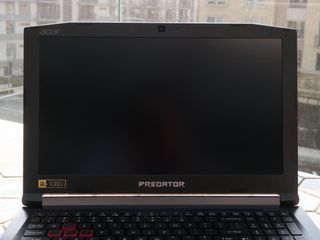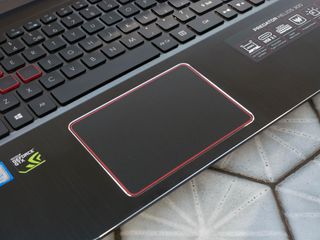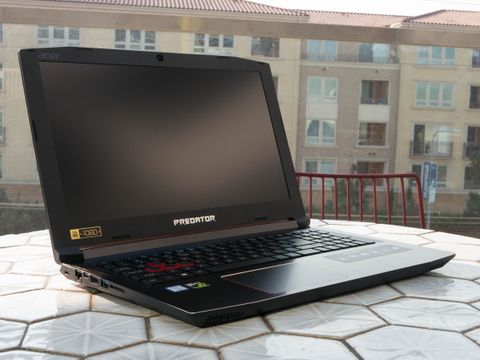Early Verdict
The Acer Predator Helios 300 isn’t without its flaws, but the performance it offers at $1,100 makes the flaws almost negligible. It’s hard to pass up a deal this enticing if you’re working with a $1,200 budget.
Pros
- +
Good build quality
- +
Excellent performance
- +
Impressive thermal dissipation
- +
Display has outstanding contrast and grayscale accuracy
Cons
- -
Slow SSD speeds, especially sequential reads/writes
- -
No HDD
- -
Mediocre battery life
- -
Poor audio quality
- -
Color accuracy
- -
Lacks necessary ports for Oculus Rift compatibility
Why you can trust Tom's Hardware
Introduction & Product Tour
The gaming laptop market has certainly been competitive lately. With similar primary components to pick from, we're seeing manufacturers try to differentiate with extra bells, whistles, and spinning chrome wheels. That's why we're sometimes pleasantly surprised when a manufacturer sends us a straightforward, no-nonsense gaming laptop. All the extravagant features aside, what gamers value most is pure, unadulterated performance.
Acer's Predator Helios 300 is just such a straightforward, no-nonsense gaming laptop. Inside, it's got the Intel Core i7-7700HQ processor and the Nvidia GeForce GTX 1060, but somehow it is priced at an unheard of $1,100.
Specifications
Packaging



The Acer Predator Helios 300 arrived in a generic black shipping box decorated with the company’s logo and Predator branding. At the top of the box, there’s a black plastic handle for easy carrying.





Inside, you’ll find a much more elegant black box surrounded by four blocks of foam. This box, which houses the Helios 300, features a glossy engraving of the Predator logo on the top and the product name on the front and back sides. Inside, you’ll find the laptop itself, as well as thin sheets of additional foam on the top and bottom covers.



Back inside the shipping box, you’ll find a plain brown box housing the power adapter and an AC power cord. The shipping box also contains a black envelope with additional branding. Inside, there’s a Predator Premium Service card, a quick guide, customer service contact information, and a setup guide.
Overall, the Predator Helios 300’s packaging is fairly standard, and at this price we don’t expect additional bells and whistles.
Exterior




When we first opened the Helios 300’s black enclosure, we couldn’t help but notice that it looked strikingly similar to Acer’s Aspire VX 15. You’ll notice two red accent bars running diagonally on each side of the logo. Like the Aspire, these accent bars are merely plastic decorations; if you want bars that light up, you’ll have to step up to one of Acer’s higher end Predator models.


The Helios 300 sets itself apart from the Aspire with its brushed metal lid construction, which provides the lid, and by extension, the display, more stability. At the top end of the lid, the brushed metal ends, and you’ll find a long piece of plastic spanning the length of the lid. Taking a closer look, you’ll notice a triangular pattern, which gives the Helios 300 a “tactical” aesthetic. Finally, rather than Acer’s company logo, the Helios 300 features silver Predator branding with black chambered edges.








Moving inside, you’ll find the same brushed aluminum construction around the keyboard and touchpad. Unfortunately, this means that fingerprints and smudges are easily imparted on the surface, so you’ll need to wipe it down daily if you want to keep the Helios 300 pristine. The keyboard is slightly recessed beneath the rest of the surface to prevent contact with the display.
Acer keeps the Helios design clean and simple. There are various stickers illustrating the system’s specs just below the keyboard, and you can find a Dolby Audio logo painted on the top right corner in gray. Just beneath this is a power button, which takes its place as one of the keys on the keyboard.




The Helios 300's display is bordered by 0.875" side bezels. The top bezel is 0.625" at the slimmest point and 0.875” at the widest point.The bottom bezel is the widest at 1”. There are two feet on each side bezel, two on the bottom bezel, and four on the top bezel to prevent the display from making contact with the laptop when closed. At the top, you’ll find a 2.0 megapixel camera surrounded by array microphones. Finally, the company logo is engraved on the bottom bezel in dull silver.



The edges of the laptop are constructed from two materials. The top lid layer is made of the same brushed metal material, which wraps its way partially around the top layer. The rest of the edges are constructed out of hard plastic with a grainy texture, which wraps around from the bottom panel. The front edge angles inward from the sides. A chrome border is applied to the edges surrounding the input area, which gives the Helios’ aggressive appearance a hint of elegance. However, we’ve found the silver border to be rather soft, so it will likely experience nicks and scratches over time. Finally, the rear edge displays the laptop’s supercar-like exhaust vents. Only the left half of the vents are functional. The right vents don’t have holes; they’re simply there for symmetry.









The bottom panel is constructed out of a hard, grainy plastic. It starkly contrasts the clean, crisp metal surfaces with a more aggressive appearance, which stems mostly from its intake vents and stabilization feet. There are four angular feet at each corner of the laptop. The vents are centered mostly around the rear end of the chassis, where the heat-generating components, like the CPU and GPU, reside. Near the front, you’ll find faux speaker grilles which, while intricately designed, only serve as decoration. The actual speaker grilles are placed at the front corners next to the rubber feet.


The Predator Helios 300’s speakers are facing downwards. Unfortunately, they don’t produce good audio; maximizing the volume creates a fair amount of distortion, and the volume doesn’t scale very high. Also, the downwards direction affects clarity. With speakers this poor, the audio would have been better served with an upwards facing placement below the keyboard.



The hinge construction is mostly plastic, with a portion of the lid’s metal surface wrapping around its bottom. Depending on the angle of the hinge, you’ll be able to see a hint of the rear exhaust’s red accents. The hinge offers a decent 145° of motion.


The Acer Predator Helios 300 takes a bare-bones approach to I/O ports. On the left, you’ll find a Kensington lock, an RJ-45 LAN port, a USB 3.1 Type-C port, a USB 3.0 port, and an SD card reader. On the right, you’ll find a combination headphone/microphone jack, two USB 2.0 ports, and the DC power input. Based on the specs, the Helios 300 has enough power to run a VR headset. [Editor's note 11/1/2017 10:30 am PT: We've updated this section slightly. Previously we reported, in error, that the Helios 300 did not have the ports to support an Oculus Rift HMD. It does.]
Display

The Predator’s display is fairly standard. It’s a 15.6” Full HD (1920x1080) IPS display with a matte coating. It’s notably lacking G-Sync, but we wouldn't expect it at this price point—typically that feature will add a $200 premium.
The included HDMI 2.0 port allows users to connect an additional UHD display.
Input Devices



The Helios 300 features a full-length keyboard with a number pad, which some vendors seem to forego in their 15.6" models. The keys are well spaced and comfortable to type with, and the bumpy actuation is satisfying. The keycaps feature white text, with the WASD keys containing red text and borders. The keycap text is translucent so that the red backlighting shines through when the system is powered.
The function row has several preset functions: F3 toggles wireless connectivity, F4 puts the laptop to sleep, F5 opens the Project menu, F7 toggles touchpad functionality, F8 mutes the audio, and F9 toggles backlight brightness. Additionally, Home, Page Up, Page Down, and End act as media keys. Finally, the Up and Down keys adjust volume while the Left and Right keys adjust display brightness.

The touchpad takes design cues from the edges of the laptop, with a chrome border and red lining on its edges. The similarities end there, however. Tracking with the touchpad is rather jerky, and the surface is prone to drag, making the already mediocre tracking even more difficult to cope with unless you clean it often. Left and right clicks are uneven. The top half of the touchpad has a shallow click, whereas the bottom portion has a much deeper endpoint. Dust and debris can easily slip under the touchpad from the bottom end. You're best off using a dedicated mouse.
Interior




The bottom panel features two easy access plates that shelter the memory and HDD slots, so you can easily upgrade either of these without having to remove the entire panel. Each of the plates is held to the panel using a single screw. As for the rest of the panel, you must remove 14 additional screws. The panel is secured rather tightly, so you might need a small object like a Flathead screwdriver or credit card to loosen it. Once removed, you’ll have access to the rest of the components.





Near the front lip and HDD slot, you’ll find the 4-cell 48Wh lithium-ion battery. You’ll find the M.2 slot to the right of the RAM slots. Finally, you’ll find a Qualcomm Atheros QCNFA344A, which handles the Helios’s wireless and Bluetooth connectivity. The two speakers are located on opposite ends of the left and right edges.



The Predator’s cooling solution resides near the rear edge. It consists of a large heatsink for the Nvidia GeForce GTX 1060 and a smaller heatsink for the Intel Core i7-7700HQ. Two large heat pipes run from the CPU heatsink over the GPU heatsink and end at the two exhaust fan heat fins. An additional heat pipe runs from the GPU to the fans.
Software
Acer’s PredatorSense software runs on the Helios, although it’s been cut down substantially, perhaps to reflect the Helios’ price. Here, you’re given statistics such as CPU and GPU temperature and fan speed. PredatorSense also allows you to toggle between automatic and maximum fan speed, or create your own fan profile.
MORE: Best Gaming Laptops
MORE: Gaming Laptop Previews
MORE: All Laptop Content

Latest Valve Proton Experimental update enables DLSS 3 Frame Generation and fixes performance in dozens of games

The PS5 Pro is surprisingly efficient — 30% performance uplift while operating at nearly the same power draw as the base PS5

Elon Musk's xAI reportedly shifts $6 billion AI server order from troubled Supermicro to its rivals
-
AgentLozen ReplyAlexander Quejado said:Acer has done a stellar job with the Predator Helios 300. It offers gaming performance that’s unparalleled at its price point, making it our top value choice for gaming laptops.
This laptop wasn't given an award? I was under the impression that hardware that performs well and was an excellent value for it's class usually got editor awards.
/shrug -
chequecer60 Come on guys. This laptop has the same specs, plus an RGB keyboard, USB 3.1 Type-C and Display Port. $999 before shipping. If you use their promo code it's $949.Reply
https://www.cyberpowerpc.com/system/Halloween-Tracer-II-15-VR
Make sure to get the free mouse pad. -
anbello262 Reply20324198 said:Alexander Quejado said:Acer has done a stellar job with the Predator Helios 300. It offers gaming performance that’s unparalleled at its price point, making it our top value choice for gaming laptops.
This laptop wasn't given an award? I was under the impression that hardware that performs well and was an excellent value for it's class usually got editor awards.
/shrug
Maybe the article was silently updated, but I can clearly see that it does have an award... -
AgentLozen I see that now. I'm 99% confident that award wasn't there when I originally posted that message. Best explanation is that either 1. I'm blind or 2. The article was ninja-editedReply -
DuncDog There were some things missing from this review that seems out of place given the normal processes for Tom's Hardware Reviews... CPU Stress Testing, CPU Temperature Testing, CPU/GPU Throttling Testing, Audio Ramp Up of Fan Assembly?Reply
I only recalled seeing NotebookCheck's review back in August of an almost identical sku Helios 300, and seeing markedly different results here in so far as Temps are concerned.
>For instance, here is a direct quote from their review of the cooling assembly:
"Our stress test showed that the heat produced by the CPU and GPU is not transported out of the case fast enough. We measured a maximum CPU temperature of 97 °C (~206.6 °F). Nonetheless, the CPU managed to keep up the core clock rate over the entire one-hour test period. The maximum temperature we measured on the GPU was 84 °C (~183.2 °F). It has no thermal throttling."
>Where was any of that here? They also noted this about the fan assembly on their unit:
"What bothered us, however, was the high-frequency noise that the fans started emitting at partial load."
Unless Acer pulled a massive factory side initiative to resolve both of those issues, there seem to be some pits in the Tom's Review of this Laptop because the striking difference in readings gives the impression of 2 entirely different pieces of hardware. We are taking order of magnitude differences here. 97C vs ~60C on CPU and 82C vs 67C on the 1060s.
Here is the other review for reference:
https://www.notebookcheck.net/Acer-Predator-Helios-300-7700HQ-GTX-1060-Full-HD-Laptop-Review.242962.0.html
